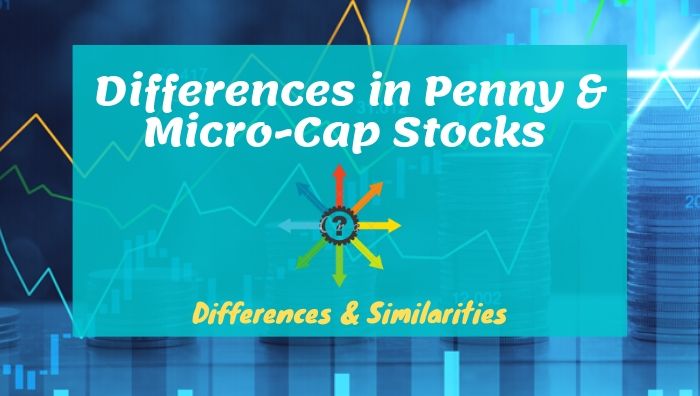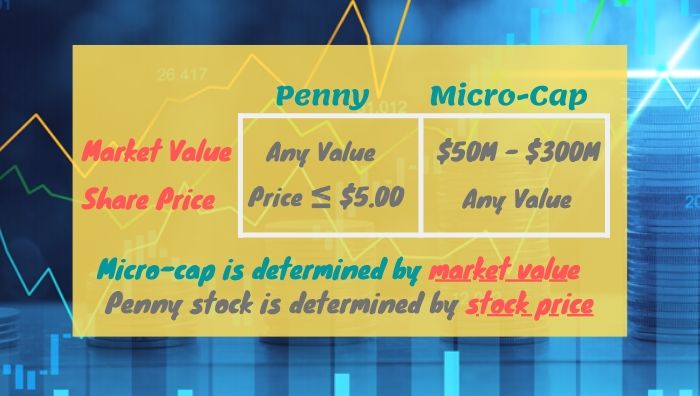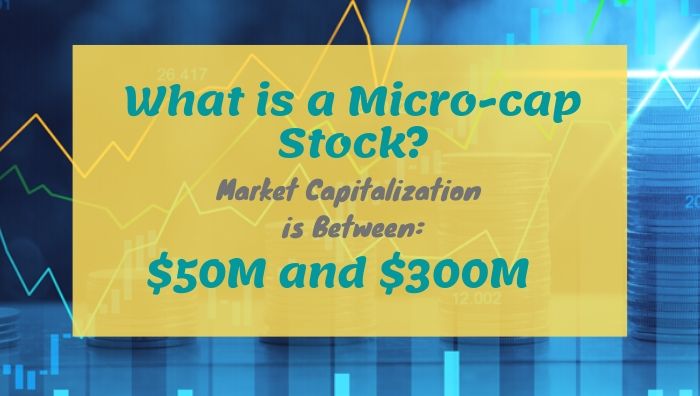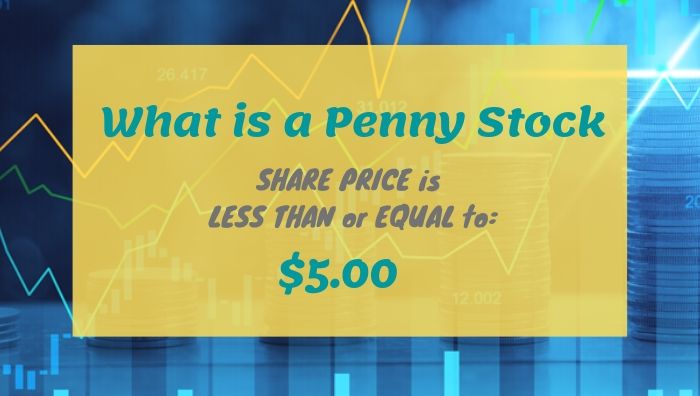
Often, there is confusion in the differences between micro-cap stocks and penny stocks. A penny stock can be a micro-cap stock and a micro-cap stock can be a penny stock. Confused? Don’t worry, you are in good company. Here are the differences between the two.
Micro-cap and Penny Stock Differences

The main difference is a micro-cap stock is determined by its market value and a penny stock is determined by its share price.
A micro-cap stock is determined by its market capitalization (shares outstanding times share price). Micro-cap stocks are companies with a market value between $50 million and $300 million. Thus, micro-cap stocks could have any share price.
Whereas a penny stock is determined by its share price, not market capitalization. Brokers and institution definition vary but it is always determined by the stock price. Penny stocks are companies with a share price equal to or less than $5.00. This can be subjective depending on the institution. Some say less than $1 and others less than $3.00. The general consensus is $5.00. Therefore, penny stocks could have any market capitalization.
What is a Micro-cap Stock

A micro-cap stock is a stock that has a market value (capitalization) between $50 million and $300 million. Its share price ranges from $0 to $1,000+. This means a micro-cap stock is also penny stock if its share price is less than or equal to $5.00 and its market value is between $50M – $300M.
What is a Penny Stock

A penny stock is a publicly traded company with a stock (or share) price less than or equal to $5.00. The definition varies from institution to institution. It is determined by its stock price and not market value. A penny stock can have a market capitalization of $100B.
Micro-cap & Penny Stock Similarities
Here are a few similarities between the two. As with any investment, only invest the amount you are willing to lose. Learn how to invest in micro-cap stocks.
Fraud and Pump & Dump Schemes
Both are subject to fraud relative to other stocks that don’t fall into penny or micro-cap stocks. A common scheme is pump and dump. The company or shareholders hire a stock promoter who sends positive messaging about the company’s potential. For example, touting a new innovative product that will make billions in revenue or a medical device. This is the pump. Investors are excited and purchase shares driving up the stock price. Next, insiders or the company sells shares while the price climbs…the dump. This leaves investors holding the bag.
Price Manipulation
Penny and micro-cap stocks share prices are often manipulated. A price manipulator buys lots of shares overtime to reduce the amount of shares available to the public. Next, the price manipulator hires a stock promoter and pumps the stock. Because there are limited shares, the price is manipulated higher than it would have been. Once the price climbs, the price manipulator sells the shares.
Explosive
Volatility is often related with penny and micro-cap stocks. Because of pump and dump schemes, fraud, and price manipulation; share prices increase or decrease rapidly. It is not rare for a penny stock to climb 300%+ in a few weeks. This is the allure and why people invest in micro-cap stocks and penny stocks. However, there are many risks to investing in micro-cap stocks and the share price falls just as quickly.
Illiquid
Low volume is more typical of penny and micro-cap stocks. While they have volatile periods, more often than not there are only a few shares trading hands a day. For example, only a few thousands shares trade a day versus larger companies like Apple where millions of shares exchange hands a day. Illiquidity or low volume makes it more difficult to sell shares (or buy them) without influencing the share price.
Market Exchanges
Usually micro-cap and penny stocks trade on Pink Sheets or OTC Markets. Many don’t have the resources to pay fees associated with senior exchanges like NASDAQ, NYSE, etc. In addition, many do not meet the requirements that more senior exchanges institute to reduce fraud. Although, this is not always the case. In fact, during crises like the Great Financial Recession and Coronavirus, many companies on senior markets became penny stocks like Ford.
Reporting Requirements
Because many penny and micro-cap stocks trade on OTC or Pink Sheet Market Exchanges, there are fewer requirements. In fact, the Pink Sheet market has no reporting requirements. This makes it extremely difficult to get any financial reports as companies are not obligated to provide them. However, this does make it easier to weed out the winners from the losers with a micro-cap screener.
Limited Analyst Coverage
With limited coverage, it is harder for micro-cap and penny stocks to find new investors. Thus, share price usually remains repressed and contributes to low volume. Apple has every institution covering it; however, smaller companies have none to a few junior analysts. This allows savvy private investors to capitalize on the inefficiencies in penny and micro-cap stocks. Because they are not followed, finding a hidden gem that is undervalued is more feasible.
Why do Institutions and Hedge Funds Avoid Penny & Micro-cap Stocks?

Many institutions are managing billions of dollars. They need to allocate capital efficiently in a few large companies versus hundreds of smaller companies. It is easier to research larger companies. In addition, these larger companies often have investor relation employees whose job is to cater to shareholders and potential investors. Lastly, an institution or fund trying to establish a position in a micro-cap stock can drive up the share price due to illiquidity. It is also more difficult for a fund to exit a position with low volume.
Can A Penny Stock Be A Micro-Cap Stock?
Yes, if a penny stock has a market value between $50 million and $300 million it is considered a micro-cap stock too. There are many penny stocks that are micro-cap stocks. To find penny stocks that are also micro-cap stocks, simply run a filter on a stock screener. Simply filter for market capitalization and stock price criteria.
Micro-cap Stock Volatility
Micro-cap stocks can be significantly more volatile than their counterparts due to active day traders pushing the price up rapidly. However, the opposite is also true. Because micro-cap stocks do not receive a lot of media coverage the surge in volume can decline just as rapidly. It also means that the bid and ask price can vary widely causing price volatility on limited volume.
Can a Micro-cap Stock be a Penny Stock?
Yes, if a micro-cap stock has a share price equal to or less than $5.00 it is a penny stock too. Many micro-cap stocks are also penny stocks. The easiest way to check is to run a stock screener for market values between $50 million – $300 million and share price less than $5.00. This reveals all of the stocks that are micro-cap and penny stocks.
Final Thoughts
The main difference between a penny stock and a micro-cap stock is one is determined by share price whereas the other is determined by market value. Hence, a penny stock can also be a micro-cap stock and visa versa. They are high risk investments compared to blue-chip stocks. Stay safe, keep learning. One day you will retire on a beach and invest in stocks. Do what you want, when you want.
Subscribe To Microcap Newsletter
By entering your email address you agree to get email updates from Microcap Spotlight. We'll respect your privacy and unsubscribe at any time.
Recommended Reading
How to Invest in Micro-cap Stocks
Ready to learn about the ins and outs on how to invest in micro-cap stocks. Investing in micro-cap stocks (also known as microcap) is not for beginners.
What is a Micro-Cap Stock? Everything You Need to Know!
A microcap stock is a publicly traded company with a market value that is between $50 million and $300 million. They trade on OTCQX, OTCQB and Pink Markets.
Top Reasons to Avoid Penny & Micro-cap Stocks
There are lots risks to avoid when investing in penny & micro-cap stocks. The excitement of making a quick return is aluring, but the odds are against you.
Micro-cap Stock Screener: Everything You Must Know
A Micro-cap stock screener is a powerful tool for investors and traders if used correctly. Understanding what & how to use a stock screener is critical.
